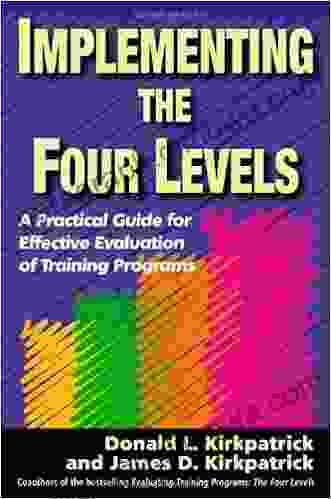The Ultimate Guide to Evaluating Training Programs

4.4 out of 5
| Language | : | English |
| File size | : | 2011 KB |
| Text-to-Speech | : | Enabled |
| Screen Reader | : | Supported |
| Word Wise | : | Enabled |
| Print length | : | 168 pages |
Training is a critical investment for any organization. It can help employees develop new skills, improve their performance, and increase their knowledge. However, without effective evaluation, it is difficult to know whether training programs are meeting their objectives and delivering a positive return on investment (ROI).
This comprehensive guide provides practical strategies and tools for effectively evaluating training programs. We will cover the entire evaluation process, from planning and design to data collection and analysis. By following the steps outlined in this guide, you can ensure that your training programs are meeting their goals and delivering a positive ROI for your organization.
Chapter 1: Planning and Design
The first step in evaluating a training program is to develop a clear plan and design. This plan should articulate the program's objectives, identify the target audience, and outline the evaluation methods that will be used.
Objectives
The objectives of your training program should be specific, measurable, achievable, relevant, and time-bound (SMART). SMART objectives will help you to focus your evaluation efforts and ensure that you are collecting the right data.
Target Audience
The target audience for your training program is the group of employees who will be participating in the program. It is important to identify the target audience early in the planning process, as this will determine the content and delivery of the program.
Evaluation Methods
There are a variety of evaluation methods that can be used to assess the effectiveness of training programs. Some of the most common methods include:
* Kirkpatrick's Four Levels of Evaluation * Return on Investment (ROI) * Participant Satisfaction * Behavior Change * Knowledge Gain
The specific evaluation methods that you use will depend on the objectives of your training program and the resources that you have available.
Chapter 2: Data Collection
Once you have developed a plan and design for your training evaluation, you need to collect data to assess the program's effectiveness. There are a variety of ways to collect data, including:
* Surveys * Interviews * Focus groups * Observation * Data analysis
The data that you collect will depend on the evaluation methods that you are using. For example, if you are using Kirkpatrick's Four Levels of Evaluation, you will need to collect data on participant reaction, learning, behavior change, and results.
Chapter 3: Data Analysis
Once you have collected data, you need to analyze the data to assess the effectiveness of your training program. There are a variety of statistical methods that can be used to analyze data, including:
* Descriptive statistics * Inferential statistics * Regression analysis * Meta-analysis
The specific statistical methods that you use will depend on the type of data that you collected. For example, if you collected quantitative data (e.g., survey responses),you can use descriptive statistics to summarize the data and inferential statistics to test hypotheses about the data.
Chapter 4: Reporting and Interpretation
The final step in evaluating a training program is to report and interpret the results. The report should be clear, concise, and easy to understand. It should provide an overview of the evaluation process, the data that was collected, and the findings of the analysis.
The interpretation of the results should be based on the objectives of the training program. For example, if the objective of the training program was to improve employee performance, then the interpretation should focus on whether or not the program was able to achieve this objective.
Evaluating training programs is essential for ensuring that they are meeting their objectives and delivering a positive ROI. By following the steps outlined in this guide, you can ensure that your training programs are effective and that you are getting the most out of your training investment.
4.4 out of 5
| Language | : | English |
| File size | : | 2011 KB |
| Text-to-Speech | : | Enabled |
| Screen Reader | : | Supported |
| Word Wise | : | Enabled |
| Print length | : | 168 pages |
Do you want to contribute by writing guest posts on this blog?
Please contact us and send us a resume of previous articles that you have written.
 Book
Book Novel
Novel Page
Page Chapter
Chapter Text
Text Story
Story Genre
Genre Reader
Reader Library
Library Paperback
Paperback E-book
E-book Magazine
Magazine Newspaper
Newspaper Paragraph
Paragraph Sentence
Sentence Bookmark
Bookmark Shelf
Shelf Glossary
Glossary Bibliography
Bibliography Foreword
Foreword Preface
Preface Synopsis
Synopsis Annotation
Annotation Footnote
Footnote Manuscript
Manuscript Scroll
Scroll Codex
Codex Tome
Tome Bestseller
Bestseller Classics
Classics Library card
Library card Narrative
Narrative Biography
Biography Autobiography
Autobiography Memoir
Memoir Reference
Reference Encyclopedia
Encyclopedia Jacques Chaize
Jacques Chaize James Nathaniel Holland
James Nathaniel Holland Jacquie Abram
Jacquie Abram Tony Demarco
Tony Demarco Jane O Connor
Jane O Connor Kathy Lockwood
Kathy Lockwood Ulrich Weiss
Ulrich Weiss James Cobern
James Cobern J Jasper Clarkson
J Jasper Clarkson Jane Werner
Jane Werner Selbstorientiert
Selbstorientiert James Steward
James Steward James Proctor
James Proctor James Robert Parish
James Robert Parish Marcel Berger
Marcel Berger Siobhan Davis
Siobhan Davis Paul Murrell
Paul Murrell Margot Wood
Margot Wood Jack Clark Francis
Jack Clark Francis Scott L Hoffman
Scott L Hoffman
Light bulbAdvertise smarter! Our strategic ad space ensures maximum exposure. Reserve your spot today!

 Tennessee WilliamsUnveiling the Inspiring Journey of Soldier Girl: A Captivating Book That Will...
Tennessee WilliamsUnveiling the Inspiring Journey of Soldier Girl: A Captivating Book That Will...
 Terry PratchettMore Stories of Life, Love, and Baseball in Japan: Yellow Black Fever Series
Terry PratchettMore Stories of Life, Love, and Baseball in Japan: Yellow Black Fever Series Tennessee WilliamsFollow ·18.7k
Tennessee WilliamsFollow ·18.7k Austin FordFollow ·14.7k
Austin FordFollow ·14.7k Kurt VonnegutFollow ·15.3k
Kurt VonnegutFollow ·15.3k Isaac BellFollow ·8.2k
Isaac BellFollow ·8.2k Bob CooperFollow ·19.5k
Bob CooperFollow ·19.5k Octavio PazFollow ·14.3k
Octavio PazFollow ·14.3k Amir SimmonsFollow ·2.8k
Amir SimmonsFollow ·2.8k Hector BlairFollow ·6.2k
Hector BlairFollow ·6.2k

 William Golding
William GoldingWhere Dreams Descend: A Literary Gateway to a Kingdom of...
Prepare yourself for a...

 Joseph Conrad
Joseph ConradAmy Tan: Asian Americans of Achievement
Amy Tan is an...

 Fredrick Cox
Fredrick CoxAn Acorn Frog and Dog: An Unforgettable Adventure for...
Embark on an enchanting journey with "An...

 Robert Reed
Robert ReedAnna Sui: An Inspiring Asian American Role Model
Anna Sui is a...

 Jeremy Cook
Jeremy CookGrowing Up in Slavery: An Unforgettable and Harrowing...
A Window into a Forgotten...
4.4 out of 5
| Language | : | English |
| File size | : | 2011 KB |
| Text-to-Speech | : | Enabled |
| Screen Reader | : | Supported |
| Word Wise | : | Enabled |
| Print length | : | 168 pages |










